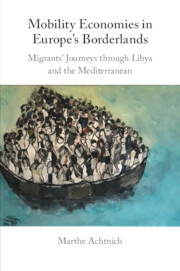Refine search
Actions for selected content:
121 results
5 - Assassinations in Nicosia and Madrid, Attacks in Jordan and Sudan
- from Part II - Europe’s Covert War against the Palestinian Armed Struggle
-
- Book:
- Operation Wrath of God
- Published online:
- 12 August 2025
- Print publication:
- 07 August 2025, pp 111-147
-
- Chapter
- Export citation
M’addibs and Migrant Laborers: Migration from Ottoman Trablus al-Gharb to Djerba, Tunisia in the Early 20th Century
-
- Journal:
- International Journal of Middle East Studies , First View
- Published online by Cambridge University Press:
- 04 August 2025, pp. 1-19
-
- Article
-
- You have access
- Open access
- HTML
- Export citation
The psychological impact of storm Daniel on medical students at the University of Derna in Libya: A cross-sectional study
-
- Journal:
- Cambridge Prisms: Global Mental Health / Volume 12 / 2025
- Published online by Cambridge University Press:
- 17 July 2025, e82
-
- Article
-
- You have access
- Open access
- HTML
- Export citation
EXIT RIGHTS, SEAMLESS BORDERS AND THE NEW CARCERAL STATE
-
- Journal:
- International & Comparative Law Quarterly / Volume 73 / Issue 4 / October 2024
- Published online by Cambridge University Press:
- 18 December 2024, pp. 891-929
- Print publication:
- October 2024
-
- Article
-
- You have access
- Open access
- HTML
- Export citation
5 - North Africa, Islam and the Great Civilisation
- from Part II - Forming an Africa Policy (1971–1975)
-
- Book:
- Pahlavi Iran's Relations with Africa
- Published online:
- 13 June 2024
- Print publication:
- 27 June 2024, pp 119-149
-
- Chapter
- Export citation
2 - The Homeric king of Sparta: Menelaos in a Spartan Mediterranean
-
- Book:
- Myth and Territory in the Spartan Mediterranean
- Published online:
- 31 October 2024
- Print publication:
- 13 June 2024, pp 46-66
-
- Chapter
- Export citation
3 - The UN Security Council: Between Centralism and Regionalism
-
-
- Book:
- The UN Security Council and the Maintenance of Peace in a Changing World
- Published online:
- 15 February 2024
- Print publication:
- 22 February 2024, pp 186-277
-
- Chapter
-
- You have access
- Open access
- HTML
- Export citation
International memories in global politics: Making the case for or against UN intervention in Libya and Syria
-
- Journal:
- Review of International Studies / Volume 50 / Issue 2 / March 2024
- Published online by Cambridge University Press:
- 13 November 2023, pp. 271-288
- Print publication:
- March 2024
-
- Article
-
- You have access
- Open access
- HTML
- Export citation
Conclusion
-
- Book:
- Mobility Economies in Europe's Borderlands
- Published online:
- 12 October 2023
- Print publication:
- 26 October 2023, pp 168-175
-
- Chapter
- Export citation
3 - Waiting
- from Part I - Libya
-
- Book:
- Mobility Economies in Europe's Borderlands
- Published online:
- 12 October 2023
- Print publication:
- 26 October 2023, pp 83-103
-
- Chapter
- Export citation
1 - Detained
- from Part I - Libya
-
- Book:
- Mobility Economies in Europe's Borderlands
- Published online:
- 12 October 2023
- Print publication:
- 26 October 2023, pp 29-57
-
- Chapter
- Export citation
2 - Staying On
- from Part I - Libya
-
- Book:
- Mobility Economies in Europe's Borderlands
- Published online:
- 12 October 2023
- Print publication:
- 26 October 2023, pp 58-82
-
- Chapter
- Export citation
Introduction
-
- Book:
- Mobility Economies in Europe's Borderlands
- Published online:
- 12 October 2023
- Print publication:
- 26 October 2023, pp 1-26
-
- Chapter
- Export citation
4 - Turbulence at Sea
-
- Book:
- Mobility Economies in Europe's Borderlands
- Published online:
- 12 October 2023
- Print publication:
- 26 October 2023, pp 104-116
-
- Chapter
- Export citation
Facing displacement and a global pandemic: evidence from a fragile state
-
- Journal:
- Journal of Demographic Economics / Volume 90 / Issue 3 / September 2024
- Published online by Cambridge University Press:
- 25 October 2023, pp. 460-485
-
- Article
-
- You have access
- Open access
- HTML
- Export citation

Mobility Economies in Europe's Borderlands
- Migrants' Journeys through Libya and the Mediterranean
-
- Published online:
- 12 October 2023
- Print publication:
- 26 October 2023
Introduction
-
- Book:
- The Local Impact of the International Criminal Court
- Published online:
- 06 July 2023
- Print publication:
- 20 July 2023, pp 1-8
-
- Chapter
- Export citation
7 - Societal Impact II
-
- Book:
- The Local Impact of the International Criminal Court
- Published online:
- 06 July 2023
- Print publication:
- 20 July 2023, pp 217-260
-
- Chapter
- Export citation
Postscript
-
- Book:
- The Local Impact of the International Criminal Court
- Published online:
- 06 July 2023
- Print publication:
- 20 July 2023, pp 282-284
-
- Chapter
- Export citation
3 - Systemic Effect II
-
- Book:
- The Local Impact of the International Criminal Court
- Published online:
- 06 July 2023
- Print publication:
- 20 July 2023, pp 83-115
-
- Chapter
- Export citation
